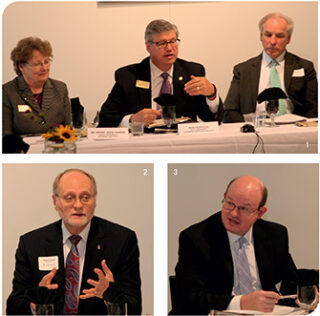HOME | ABOUT US | MEDIA KIT | CONTACT US | INQUIRE
HOME | ABOUT US | MEDIA KIT | CONTACT US | INQUIRE
Page 2
As an opening question, participants were asked what it was that kept them awake at night. The range of answers spoke to diversity of their missions.

1. Flanked by Sister Marie Joan Harris and moderator Jack Cashill, assembly chair Ron Slepitza summarized the themes he heard from participants’ opening statements. | 2. Michael Droge emphasized the vital contribution that innovation by administrators would play in the success of higher education. | 3. Hal Higdon joined others from public institutions in criticizing the trend by states to cut back on appropriations for higher education.
Park University faces a significant challenge that the other institutions did not: the downsizing of the U.S. military. As Chancellor Michael Droge explained, Park has emerged as arguably the leading provider of educational services to the American military nationwide. A reduction in force means a potential reduction in enrollment.
“We are finding that we have to change in the ways that we serve,” said Droge. This means remaining flexible, finding new resources, and keeping the active military and veterans on track to complete their educations. “That’s just something that has to be done,” Droge added. “We’re just going to be innovative about that.”
Missouri State University in Springfield, like all state institutions, has to deal with state funding issues. President Clif Smart singled out as a concern the legislature’s inclination to reduce revenue by cutting taxes and the governor’s subsequent withholding of funds. “That’s by far the biggest struggle for us,” said Smart.
As president of “the lowest-funded community college in Missouri and one of the 10 worst-funded community colleges in the country,” Ozarks Technical Community College, said Chancellor Hal Higdon, shares Smart’s concerns about state funding. With only 13 percent of its budget provided by the state of Missouri, Higdon felt he had “more in common with the private institutions in this room than the public ones.”
“We are very concerned about what’s happening in terms of the diminishing state support for public institutions,” affirmed Cindy Heider, associate provost at Missouri Western State University. This was a special concern for Heider, as Missouri Western has an open-admissions policy and an imposed a tuition cap. “Where other institutions in other situations have flexibility in terms of raising tuition rates,” said Heider, “we do not.”
Kansas universities face the same challenge, confirmed Shawn Naccarato, director of government and community relations at Pittsburg State University. Dealing with the state Legislature keeps Naccarato fully engaged. “I think broader than that for the institution,” added Naccarato, “it is about how do we remain relevant, competitive, and properly aligned with the economy and with society.”
What most concerned Shawn Hull, a division chair at William Woods University, was “the level of unsustainable student debt.” He noted, too, that once debt levels of individual students surpass $20,000, they generally cease to be potential donors to the university.
Brian Messer, dean and president for Baker University School of Professional and Graduate Studies, worries most about affordability. He believes that more informed “self management” on the part of students will help the university retain viability 10 or 15 years down the road. KU professor Rich Simpson agreed that it was imperative for all universities to making sure students were able to pay tuition.
“What worries me in a broader perspective,” said John Rich, director of student affairs and alumni at the School of Business of Emporia State University, “is how difficult it is for some people to go to school today. The cost is high. You can borrow money, but there are all kinds of consequences with that.”
For Steve Minnis, president of Benedictine College, a constant concern is enrollment. As Minnis noted, enrollment dropped by about 2.5 percent nationwide from 2010 to 2012, but at private institutions enrollment decreased 10 percent. He sees this trend continuing for the next decade, which could pose a real threat to the sustainability of private colleges.